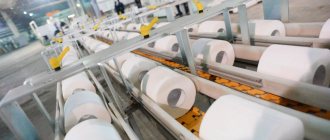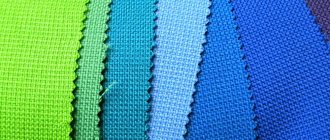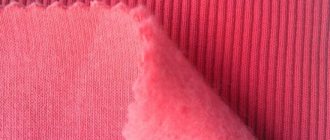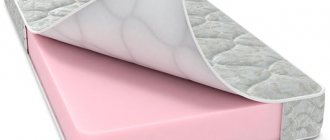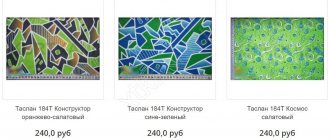What is ribban fabric?
Many people wonder what ribana fabric is. In other words, it is a popular type of knitwear. The production is based on double weave of threads, which is achieved using the cross-design method. Outwardly, it resembles a canvas of tightly knit rubber bands. The interweaving of front and back loops most often alternates through one. This product gives a beautiful and neat appearance. In addition, the material has excellent stretch and high elasticity.
Characteristics of knitwear
The material has won the sympathy of buyers due to its positive properties. Among them:
- Strength. The indicator varies over a wide range - from 170 to 460 g/sq.m. meter.
- Breathability. The knitting method determines the presence of microcavities between the loops. Therefore, the air circulates freely, giving the body the opportunity to “breathe”.
- Hygroscopicity. Ribana perfectly absorbs sweat, preventing the greenhouse effect.
- Thermoregulation. Elastic knitting allows you to create optimal thermal balance. In such products a person does not overheat, but at the same time does not freeze.
Another positive quality of ribana is elasticity. This is due to the presence of lycra in the composition.
How knitwear is made
Before you ask what ribana is, it is important to know that it is knitwear. Like any material of this type, it is made by knitting loops of threads. The connection of the transverse tracks forms a series of loops. The standard version of the fabric is distinguished by its formation from a single thread, which passes from row to row. There are other types of fabric. Double or triple elastic gives it relief and structure. This method produces openwork ribana, with patterns of various shapes and other decorative elements.
Composition of ribana fibers
Ribana is a cotton fabric; pure cotton threads are used for its production. But for greater elasticity and resilience, manufacturers often add lycra threads to cotton, usually no more than 5% of the volume of the material.
Polyester and viscose are added for added strength, smoothness and shine. Just like lycra, these fibers do not contain significant amounts.
Ribana with Lycra differs from pure cotton in that the former is softer, more elastic, does not shrink after washing and fits better on the figure. And, by the way, it is as safe as 100% natural material.
Composition, properties, characteristics
The fabric is based on natural cotton. For this reason, it is included in the natural category. In some cases, there may be minimal additions of the following synthetic materials.
Most often, the impurity indicator is no more than 5%:
- Lycra;
- Viscose;
- Polyester.
Many people are interested in ribana with lycra, what kind of fabric it is. Adding lycra or other synthetic materials increases elasticity. As a result, it stretches well and fits perfectly on any figure. For this reason, some people call ribana an eraser.
The admixture of viscose insulates the fabric and makes it an ideal solution for sewing winter clothes. This method is used to produce ribana with fleece. It has a soft structure and elasticity.
pros
When trying to find out what kind of ribbed fabric it is, it is important to know about the main advantages of the material. This fabric will delight you with its distinctive features.
The positive properties of the material include:
- Does not cause allergic reactions;
- It does not require special care;
- Easy to clean from dirt;
- Large color palette;
- Breathes well and protects a person from overheating;
- High degree of strength.
The material with a small addition of synthetic fabrics tends to retain its shape and stretch well. In addition, pellets do not appear on such fabric, it does not fade and does not lose color brightness over time.
Minuses
Despite the large number of positive properties, ribana, like any other material, has disadvantages. They are not so significant in comparison with the positive properties, but they deserve attention. The main disadvantage of the fabric is the high degree of fading. Prolonged exposure to sunlight can cause the ribana to lose its color brightness.
Another disadvantage is the washing process. Products made from ribana tend to absorb water. The fabric will take a long time to dry. This is especially noticeable in comparison with synthetic fabrics.
Composition and characteristics of the material
Ribana is rightfully considered a natural material. Durable, wear-resistant and pleasant to the touch, it is almost always made from 100% cotton. This is a high-quality, hypoallergenic material suitable for children’s wardrobes, which stretches, but not too much, and over time, during long-term use, it may lose shape due to deformation of the cotton threads.
The density of classic cotton ribana is usually 190 g/m2, while there is stocking ribana with a density in the range of 170-460 g/m2.
Ribana with the addition of other fibers is called transfer. The use of other fibers - polyester, lycra, viscose - is allowed in a proportion of no more than 5%, and in this case the fabric can be called “eraser”.
Depending on the type of fiber added to cotton, ribana may acquire additional properties. Thus, the addition of viscose increases the tactile qualities of the material, and the addition of lycra makes the knitwear more stretchy, and lurex gives the fabric an elegant look.
Varieties of ribana
There are two main categories into which ribana fabric is divided:
- Natural;
- With the addition of synthetics.
The first type is most often used for sewing children's clothing. This is due to its safety. The second option is otherwise called transfer ribbed and is used for sewing various products. This fabric can be equipped with openwork, decorative inserts or fleece. Synthetic ribana is dyed in the most original colors. The natural version is rarely dyed. Products made from it are often white.
Helpful information:
What kind of fabric is interlock foam?
What kind of fabric is interlock
Types of material
Today, not only ribbed knitwear is popular, but also other, relatively new varieties of knitwear.
- Footer is a dense fabric with an additional purl thread and a fleecy reverse. Elastic, soft, warm knitwear used for sewing clothes for children and adults, tracksuits and outerwear. Knitted footer has a pleasant fleecy back side; it will warm you up in the cold season without causing allergies or irritation. It can be either completely natural or with the addition of wool or synthetics.
- Interlock is a dense double-sided knitwear made using the technique of crossing loops. The surface is soft, the highest grade is perfectly smooth. It is made from cotton fibers and is completely natural. Used for sewing children's and adult clothing, tracksuits, pajamas and dressing gowns. What interlock material is is described in detail here.
- Kulirka (kulirka) is a cross-weave knitwear with a pronounced relief surface. It is formed in pigtails on the face, and in a checkerboard pattern on the inside. The thinnest of knitted materials, elastic, pleasant to the touch. Composed of either 100% cotton or cotton, with the addition of synthetics (10%). Used for sewing linen and clothes for children and adults for warm seasons.
Popular varieties of knitwear are often used when sewing home clothes. Interlock is a denser material.
In terms of qualities, ribana is close to kulirka, interlock and footer are denser and warmer. But at the cost of reban in the interlock category, you will have to pay from 260 rubles per linear meter.
More and more companies sewing from knitwear are appearing in our country, such as: “Lori-Knitwear”, the company “Caprice”.
Sewing Tips
Without knowing what ribbed knitwear is, it is important to treat the material with caution. It can be very pliable if handled correctly. By following some rules, you can achieve positive results:
- You can connect individual parts of the product using a sewing machine using a zigzag seam;
- It is important that the share line and the direction of the loops are the same;
- Make sure that the distance from the contour does not exceed 1 cm;
- Knitwear may fray. For this reason, you should work with it carefully. It is important to make precise marks along the contour;
- A special tape can serve to strengthen the shoulder and transverse seams;
- No need to stretch the material. The ribana should not be deprived of free movement while sewing.
What kind of ribana is there?
Speaking about ribana, it is important to note that this material can have different properties, depending on the manufacturing technology used. The most common are two main types - fine and large rib.
Rib with a small rib is soft, smooth, fits perfectly to the figure, and stretches well across the width. It is more often used when sewing clothes as an independent material.
Ribana, with a pronounced rib, is more often used as a knit fabric, a companion to other types of cotton-based fabrics, in order to make practical functional parts - cuffs, elastic at the bottom, it is used as a binding to sew around the neckline. This material is much more wear-resistant; it can withstand repeated stretching across its width, returning to its original shape over and over again.
Also, ribana knitwear can be insulated - with fleece and increased density. This fabric is most often used for warm children's and adult products.
How to care
Ribana does not require special care. To clean, just throw the material in the washing machine. The optimal temperature should not be more than 30°C. You should also pay attention to the washing mode. Anything except intense spin will do. This may damage the structure of the material. Hand or delicate wash is most suitable.
After finishing washing, you should carefully remove the product from the machine. Do not squeeze out the water with great force. It is enough to lightly wring out the clothes and leave them in the basin until the water drains by itself. Excessive twisting may cause the weave to become distorted, rendering the product unusable.
The product should be dried inside out, provided there is no direct sunlight. It is recommended to do this in a room where there is no strong ventilation. Otherwise, the ribana will dry unevenly and may become hard and even lose its softness. You can hang the product outside, but it is advisable to choose a place in the shade. Ironing ribbed products is also not prohibited. It is better to choose the most delicate operating modes of the iron.
Caring for ribbed items
Now that it has become clear what kind of fabric it is, it’s time to talk about caring for knitted items. Although ribbed fabric is unpretentious, proper care will help keep things in their original form for a long time.
- Let's start with washing. You can wash items made from cotton jersey either by hand or in a washing machine. It is better to use the daily wash mode, delicate or hand wash. The temperature should be 30-40 degrees. You can spin at any speed.
- If you wash by hand, do not twist the product too much when squeezing, otherwise creases will appear on the fabric. Lightly wring out the item, allow excess water to drain, or wrap the item in a thick terry towel to remove excess moisture. Then hang the item on a clothesline to dry completely.
- It is better to dry items made from cotton ribbed fabric naturally (on the balcony or in the room on a clothes dryer) or in a drying machine. After it, things are especially soft. It is better not to use batteries and other heating devices for these purposes.
- You can iron clothes and other things made from this material with a not very hot iron and it is better from the wrong side.
Ribbon items are practical and comfortable, so you should definitely have them in your wardrobe. And if you are a beginner seamstress, then feel free to buy fabric and sew clothes from it for yourself and your loved ones.
Application area
We have already said more than once that ribana knitwear is often used for sewing clothes, including for children of “infant” age. It can be used to make things for the home, stylish turtlenecks, pajamas, underwear and much more. Such models beautifully fit the figure and are practically not felt when worn. Some types of fabrics are used for stockings and garters.
Transfer rib is most often used in the clothing industry. Modern models of outerwear are sewn from it: men's, women's and children's. Also, matter is often used to make a variety of parts. Knitted collars, cuffs, and pockets look very unusual and stylish. For them, they usually take white ribana.
Stores often sell ribbed tapes - ribbons twisted into rolls, with a width from 3 cm to 9 cm and a length from 3 m to 10 m. They are used to make a variety of original crafts, decorate clothes, etc. The colors are completely different.
When sewing, the material is not demanding, but it is still necessary to carry out special processing of necklines, sleeves and other parts with edges to avoid unraveling of loops.
Advantages and disadvantages of ribbed knitwear
The advantages of this fabric include its practicality, long service life, environmental friendliness, elasticity and strength, hypoallergenicity, hygroscopicity and excellent thermoregulation. This material has practically no disadvantages, except that wet clothes take a long time to dry, and the color of cotton can fade when exposed to direct sunlight.
Important! Smooth ribana can be easily damaged if the item is not properly cared for.
Underwear
Cutting and sewing techniques using ribana
For those who are trying to sew something from ribana for the first time, it is important to follow the recommendations of experienced craftsmen for working with this fabric:
- Cutting should be carried out according to a pre-prepared tracing paper (diagram). In some cases, the model is replaced with blanks cut out of paper. Then they need to be transferred to fabric and the required blank shape cut out.
- You should not stretch the fabric transversely while cutting, as this may confuse the loops. Their direction must exactly correspond to the grain of the thread, which is marked on the canvas with chalk in the form of arrows.
- The parts cut from the canvas must be fastened manually using needles or a pin.
- Next comes the fitting process: the fastened parts are tried on and adjusted to fit the figure. After fitting and shrinkage, you can begin stitching and subsequent processing of the material.
- Regardless of what type of knitted fabric is used for cutting, it is recommended to sew ribbed parts using an overlocker. If this tool is not available, then you can use a regular sewing machine for stitching, making narrow stitches, approximately 2.5 mm long and no more than 0.5 cm wide. The advantage of this seam is that it does not tighten the fabric. When working with the canvas, it is necessary to maintain intervals of about 1.5 cm from the edges.
Baby vests for the little ones
Important! During the sewing process, the fabric should not be stretched, as this can lead to damage to the parts.
To avoid stretching of the seams on the created item, it is recommended to use special interlining fabric.
Additional Information! As a rule, woven interlining is used for lining because it is elastic and stretches well.
You might be interested in what is better for bed linen: poplin, satin or calico
Cutting option
